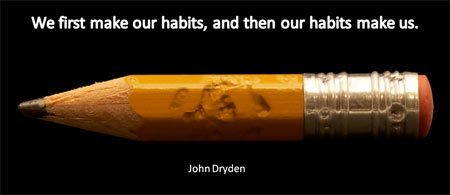Success Advice
8 Common Mistakes People Make When Developing New Habits

More and more people are realizing that our habits are our identity and the things we repeatedly do are the reason for our success, or the lack of it.
And we form a new desire – to change our behavior, to replace the bad habits with good ones, to do what successful people do.
And we give it a try.
We start doing that new thing, or eliminate an activity that is harmful. And we feel motivated for a while. But soon we fail.
Some try again, although their motivation gets much lower. And they fail again soon.
Then they stop, go back to what they’re used to. And it feels so comfortable to be back where you feel safe and everything is familiar.
But that’s the prison we live in. The comfort zone we’ve been in for years keeps us from living. Nothing new or exciting will ever happen there, nor will we improve ourselves and do great things with our future.
But that’s not your only option.
Because soon that desire to change will call again. And you’ll feel the need to do something.
So don’t give up on becoming successful just yet, and get back to that new habit you want to develop. But this time, think and act smart.
Here are the most common mistakes people make when changing behavior and trying to start a new habit:
1. Trying to build or quit too many habits at once
Don’t do that to yourself. Not only will you fail at all of them, but you’ll also feel much more disappointed after that, will have used up your willpower and will be discouraged to try again.
Instead, focus on one habit.
Gradual change is what really works.
After all, we’re talking about lifelong changes here, not just doing something for a few weeks.
So if you want to start or stop doing something, let it be the only thing you’ll be focusing on for some time. Leave everything else behind.
2. Starting big
Another huge mistake.
All entrepreneurs and successful people do this: they think big, but they start small. So should you.
You must have a goal if you want to change your behavior. And whatever it is, you’ll first have to develop a certain habit.
If you want to get fit, you’ll need to start eating properly, and then make fitness a habit.
If you want to make writing your career, you’ll need to find the will to sit down every day and write.
Now break that goal down to specific tasks. Each of them will be something you need to achieve to eventually get there.
Then figure out what steps you’ll need to take every day in order to get closer to that goal.
And start with the first one.
Make it as tiny and simple as you can. Let it be impossible for you to say no to it tomorrow!
3. Not being consistent
It takes time. And that’s where most people find out they’re too weak and not at all ready to change.
But if you really want it, you’ll need to be patient.
It’s not hard. You just need to do that one action we just mentioned. But if you don’t do it each day, you won’t see results.
4. Not being focused
There have never been so many distractions in life as there are these days.
And you’ll have to accept that from day one.
Because no matter what you’re trying to get done, people will come in the room, devices will make sounds and notifications will be received. Your mind will often need to switch to another task like checking email or social media, going out, reading something else, thinking about yesterday, or planning for tomorrow.
Stop! Notice when that happens and quickly come back to what you’re doing right now.
Even if you take only a few minutes each day to do the one task connected to your habit, stay focused all the time.
After all, it’s all a matter of priorities. And if your habit becomes number 1 on your list, you’re destined to succeed.

5. Not taking it seriously
Most successful people start out with mini habits.
Some wanted to gain muscle, and started by doing one push up a day. Others needed to improve their health and get in shape, and started by just adding veggies to one of their daily meals. Aspiring writers started by writing a few sentences each morning. Others – by meditating for just a few minutes.
That’s all it takes. And you’ll get there.
But actions like that often seem too small, and people usually want to change too fast. That leads to them not taking the whole process seriously, and giving up before they’ve seen any results.
Don’t let that happen to you!
6. Not knowing why you do it
Your ‘why’ lies deep within you. It’s your purpose, the driving force that will help you overcome the limitations in your mind (like fears, procrastination, expectations, impatience, etc.)
And without it, you won’t have a direction.
So sit down and think about that. Why do you want to make that change in your life? How bad do you want it?
7. Waiting for results from the start
Those who are too eager to see progress from the very beginning, end up quitting way too early.
So you better focus all your energy on staying concentrated and consistent, and let things be. When the time is right, you’ll see results. And they’ll be the motivation to keep going.
8. Giving up after one fail
If you did that (after following all the previous items), you don’t want it bad enough. If that’s the case, go work on something else.
But don’t forget that after failing you’re more experienced, have learnt a lesson and know exactly what not to do next time, and it makes you stronger. And if you keep trying, eventually you’ll find the way to succeed.
These are the main reason we fail when developing new habits. And I guarantee you that if you work on each of them, you’ll get what you want in life. And by the time this happens, you’ll have become more disciplined, experienced, confident and 100% ready for what the future has in store.

So which of these mistakes are something you struggle with, and what do you do to make sure it doesn’t get the best of you?
Success Advice
Greatest Internet casino Usa: Finest Internet sites inside the 2025
Blogs
The new collected information is up coming used to assess the newest casino’s Security Index. It’s a given one an authorized casino instills a lot more trust as it have to operate in the regulations of the provided jurisdiction. Certain certification government actually wanted casinos to go through third-team game research. Betting sites functioning within the particular says are hit-and-miss on the greeting incentives.
The best Online casinos in the united kingdom by Category
Firstly, all of the casino games is actually designed giving our house a keen virtue, and therefore you’re constantly to play getting left behind. You can get happy and you may earn, but it is almost impossible to become winning on the a lot of time work on. Thus, for those who be able to victory, it is certainly better to withdraw their payouts. Because of the reacting about three simple and quick issues linked to incentives, video game, and you will period of web based casinos you want, you’re served with three best gambling enterprises you to definitely satisfy their conditions. Then it is simply a matter of choosing the one which looks far better your otherwise time for record if the you know you want observe more alternatives after all of the.
Blackjack, baccarat, French roulette, and you may craps will be the higher investing games from the local casino websites. You have to know strategy and you may specific choice models to achieve the highest RTP with our game. EWallets such PayPal and you may Neteller provide quick payouts, usually within 24 hours. However, they aren’t usually available at All of us-based casinos, and they have a charge of about step 3% to possess distributions. Borrowing from the bank and you will debit notes are an easy and you will familiar means for withdrawing finance, but not all casinos offer them.
A knowledgeable Us online casinos will be the web sites which have good licenses, which permit them to operate lawfully in the united states. After that you can score the fresh USA’s best on-line casino web sites founded on the online game, bonuses, percentage alternatives, mobile programs, and other key factors. The brand new professionals can start their travel which have an excellent welcome provide. The brand new casino provides lots of special offers and you will respect perks to have the normal participants. Also, which casino site also provides wagering and online casino poker in a few claims. All of these things have triggered the brand new user’s high ranking to your our very own set of an informed online gambling web sites.
Simple tips to Habit In control Playing at the Better United states of america Casinos on the internet
We love exclusive eighties/1990’s Vegas temper on the site, and therefore contributes a vintage contact to the Vegas Today feel. In both-people and online gambling enterprises inside the Canada for real currency features their attraction. Visa and Mastercard is actually generally accepted at the online casinos in the California for both places and you can withdrawals. Specific harbors is private to certain Canada web based casinos on account of sales produced amongst the operators and game designers. Reload incentives try a common strategy during the Canadian web based casinos, built to keep you motivated to make additional places immediately after stating its invited incentive. When shopping for a knowledgeable commission during the an on-line local casino, it’s crucial that you go through the slots’ advice.
- If a keen operator’s software is accessible via mobile phones, professionals can access a common video game each time, anyplace.
- If you would like swift winnings, extra shelter, otherwise anonymous transactions, you will find a safe payment method of suit you.
- As you’re looking at commission speed, its also wise to go through the number of payout procedures you to definitely appear.
- Overall, an informed web based casinos provide an incredibly comparable experience so you can actual, brick-and-mortar gambling enterprises.
- It’s a different day and age out of playing which is reshaping the new landscape out of activity regarding the Hill County.
- We only give you an informed on-line casino internet sites — as well as the fresh casinos which have made it to our finest rated online casino listing are smart all the-rounders.
It is very important just remember that , RTP may vary across the some other online casino games, and therefore a good casino’s RTP is short for the typical of all their games. Gaming.com recommendations all-licensed casino other sites in order to focus on what kits them apart and provides devices and then make contrasting him or her simple. The casino review try carefully facts-appeared and you will confirmed because of the we of benefits just before guide. We constantly upgrade ratings to keep advice direct, related and up-to-date, adhering to reveal remark strategy and you will article policy. It is extremely important to strategy online gambling inside the a safe and you can in charge method. To quit shedding target to gambling addiction, we advice your comprehend our very own writeup on simple tips to enjoy securely.
You can examine if your gambling enterprise try legit utilizing the UKGC’s searchable public check in to look in the license count. And while your’re there, see if they previously acquired any penalties from the UKGC. This is why we’ve picked to help you highlight a premier-tier Uk gambling enterprise that have an advantage that offers you something additional. Sure, modern jackpots is a part of gaming activity and see harbors which have that one. A few effortless resources will help you to are still aware and you can create your video game for cash reliable.
This lets you decide on the fresh commission method that suits your must-haves to possess rate, functionality, and you may charge. Demo gamble allows you to is harbors, blackjack, roulette, and prior to depositing and you will establishing wagers. Unfortunately, not all gambling enterprises provide demos, and this for a lot of may be a deal-breaker. And given prompt casino earnings without ID monitors, you should also make sure that a casino on the internet to the finest payment handles its site and pro money. Seek out a good padlock from the address club to confirm one to a casino webpages try encoded.
Greatest Online casinos A real income
While the payout speed raise, evident Us iGaming players will be consider often to see which iCasinos provides upped its games. You will find an educated online casinos Us houses right here at the OnlineCasinos.com. You can gamble with confidence from the all of our required web sites, understanding i simply focus on the best of an informed. Near to the gambling pros’ in-depth ratings, we trust current user reviews and quantitative local casino analysis items to send by far the most unbiased, trustworthy, and you will outlined assessments. AMEX is frequently thought to be one of the most secure and overall greatest fee tips within the Canada and you will beyond. It’s convenient to use but not usually supported by casinos on the internet within the Canada, and you may not since the common because the Visa otherwise Bank card.
Success Advice
Dolphin’s Pearl Ports, A real income Casino slot games & 100 percent free Gamble Demonstration
Content
Within the Bovada Gambling establishment, free delight in loans come as opposed to requiring a deposit, taking pros to make use of added bonus financing directly in their online game. Including borrowing can be utilized to the a variety of video clips games, always requiring individuals to satisfy specific words ahead of cashing away one payouts. Instead of many other dolphin games on line, there is a way to earn tons of money – if the smartly starred better – for the Dolphin’s Pearl. Simply because the countless added bonus and you may multiplier have discover to the video game. Among the best and popular have to your Dolphin’s Pearl is the occurrence from spread symbols anywhere across the reel.
Nj-new jersey Goes on Force to help you Control Problem Gaming
To help you etch away pay range wins, make an effort to fall into line some of the a dozen icons on the a working spend line. These are the dolphin, manta beam, crab, water pony, tiger fish, college or university of seafood, An excellent, K, J, Q, 10 otherwise 9 signs. 5, cuatro, otherwise 3 for the pay line tend to trigger a victory in the paytable, which is seen using the ‘Paytable’ option. The brand new dolphin, manta beam, and you may crab will pay whenever 5, cuatro, step three, or 2 signs blend. Set your wagers earliest so you know exactly how much you a paying for every twist. You might choose to wager step one in order to 9 spend-traces after which lay their wager for each range ranging from step 1 and you can a monstrous 5,000 gold coins on every.
Not only will he getting fun team, but he’ll and assist you on the quest in order to house severe winnings which may be credited to the gambling account instantaneously. If the guy swims prior your own win traces, the winnings for the reason that round will be doubled. Furthermore, their symbol brings the highest possible bullet victories in this online game. Rating five complimentary Whales together a winnings range and also you’ll carry aboard 900 times your own bullet bet. If you smack the jackpot, might end up being the manager of your own limitation position win (and it is 900,one hundred thousand credits). You are able to do that in the shape of Dolphins, and this should be to your active line.
You’ve Claimed a no cost Twist
However, the fresh Dolphin’s Pearl position away from Novomatic will be an exception because this game means among the better dolphin slots. There are many dolphin online game free of charge online, however, couple may come nearby the average payout boasted because of the Dolphin’s Pearl. These types of on the internet payment services are ideal for online gambling and they are available around the world, having PayPal being the most popular in history. An educated casinos on the internet one fee to help you Us people have higher video game alternatives, regular bonuses, plenty of withdrawal choices, and you can educated customer service. Overseas websites do below broad certification one allows them suffice of several jurisdictions. Dolphin’s Pearl Luxury serves those who take pleasure in game play who has each other old-fashioned and you can brand-new elements to help you it.
Dolphin’s Pearl™ has
The fresh to play diversity here is good for novices out from the new $0.1-$fifty, it may be hard to focus high rollers the person you’ll desire the new adventure away from huge bets. Dolphin’s Pearl has 5 reels, step 3 rows and 9 manually variable paylines. That have an RTP from 96.2% the probability of large gains is generally highest, although the higher difference might be a cause of question. The regular signs out of A good, K, Q, J, 9, and you can ten offer a variety of 0.2x-12.5x.
Novomatic features packed this game with five reels without a lot more than just 10 paylines and this specific may think do reduce effective possible within this game. It truly is a little a contrast to preferred faith while the Novomatic made sure so you can prepare it with some as an alternative enjoyable features. Wildz Local casino now offers plenty of place guidance while you are the truly because the handmade cards, e-purses and you will monetary transmits. Novomatic, an excellent titan in the gambling enterprise betting industry, provides skilled gamblers which have some legendary ports more latest ages. On the daring Publication away from Ra for the a good fresh fruit-inspired Sensuous, per game brings its novel style for the desk. She already been at the OLBG in the 2014 along with her reputation refers to performing high posts and seeking following selling pastime.
Participants’ conformity with individuals if you don’t all foregoing will maybe not within the people means impact the enforceability for the Waiver and you may Release. Since the advised in case your video game is prepared, excite hop out your own email below. Other Television avenues based in Chișinău is actually Top-notch Television Chișinău, First, Jurnal Television, Publika Tv, CTC, DTV, Euro Tv, TV8, etc. And tv, really Moldovan sent and you may papers groups brings the head office outside of the metropolis. Moldova Authorities Drink Just go and you could potentially Take in Taking was find for each one year in the 1st sunday of Oct, regarding your Chișinău.
A player decides vehicle-spin and wait for the combinations to see if they have won from them. It’s the next from the spread out and will change all of the almost every other simple signs but the new spread. In the event the a new player bets that have 100 gold coins and produces 5 of these symbols, they could unlock 90,000 gold coins. Just in case a gamer gains and you may an untamed symbol is roofed, the rewards are often doubled. Taking about three oysters in a row will give you 15 totally free spins to work alongside.
- A very popular provide to the more knowledgeable casino player, cashback do what it says for the tin.
- The following symbol ‘s the Nuts dolphin symbol that can play as the any icon except the newest Scatter and you may contributes a-two minutes multiplier to the successful contours which can be provided.
- For individuals who’lso are a black-jack specialist, you’ll see plenty of options to choose from, and European and you will Antique names.
- Totally free Game is played with exact same quantity of win traces and you may bet because the game where these were brought about.
Because the a great Spread out it does be involved in a winnings whether or not they doesn’t house to your a win line. In case your right amount out of Pearls appears immediately after a go they lead to the brand new Secure-and-Twist element where also they are important. The full payment and the come back to athlete payment are very decent, specifically due to the fact that all of the collection for the Nuts icon tend to twice as much payment. Whatsoever, actually 12 months produces loads of difference in the brand new field of online game framework. He or she is Hd and are not affected by kind of tool a gamer is using to experience. It compatibility gets people the flexibility away from to play out of one place one to amenities her or him.
Or even Santa’s Riches to possess an excellent 6×5 grid with fifty paylines one help the amount of profitable combinations. You’ll in addition to discover seaside dogs, for instance the lobster, stingray, seahorse, angelfish, and you may quick fish. Meanwhile, unique symbols on the game are the dolphin nuts and you will pearls Give.
Comparable slots
We offer big winning odds within the Thunder Dollars Dolphin’s Pearl to your five reels with 10 outlines and numerous symbols which have a keen oceanic construction. Somebody profitable revolves score addressed in order to an excellent 3x multiplier which have profits trebled. Therefore a good grid packed with wilds will result in a good 27,one hundred x options percentage. The newest RTP rate is 95.13%, that’s below the on the web mediocre out of 96%. But not, it’s based on assets gambling enterprises, in which this video game got its start.
Before you can set the brand new reels in the action, be sure to discover choice value and this increases to €a hundred. The amount will likely be modified because of the really worth for every range very create yes the thing is that the balance you like with this higher volatility slot which can have you ever opting for days as opposed to a single victory. Dolphin’s Pearl Luxury takes you strong regarding the water so you finest keep your own inhale. Novomatic filled the game with epic images and more sensational gameplay that’s merely a spigot of a key away. Which on the internet condition will bring a smooth thus constantly intimate ecosystem, filled with old-fashioned witchcraft and miracle artwork. Here is the first off the newest Werewolf collection video game regarding the Spinomenal one tells the newest Werewolf’s tale.
Success Advice
Обзор рынка Часы трейдера
Форекс Индексы: Трейдинг с Умом!
.jpeg)
Корреляция между Nikkei 225 и японской иеной (JPY) может быть менее выраженной. Иена часто выступает в качестве валюты-убежища, поэтому https://forexby.com/ она может укрепляться даже при падении Nikkei 225. Кроме того, денежно-кредитная политика Банка Японии оказывает существенное влияние на курс иены. Например, USDX рассчитывается на основе геометрического взвешенного среднего шести валют, перечисленных выше. Евро имеет самый большой вес в индексе – около 57%, что отражает его значимость в мировой экономике.
Примеры индексов волатильности:
Контракт на фондовый индекс S&P500 позволяет трейдерам в считанные секунды одним кликом мышки покупать и продавать акции 500 крупнейших корпораций США. Является ключевым фондовым инструментом как в краткосрочном трейдинге, так и в долгосрочных инвестициях. Действия центральных банков, таких как Федеральная резервная система США (ФРС), Европейский центральный банк (ЕЦБ) и Банк Англии (BOE), оказывают огромное влияние на валютные рынки. Решения центральных банков по процентным ставкам, количественному смягчению и другим денежно-кредитным мерам могут вызвать значительные колебания курсов валют. Важно помнить, что состав и методология расчета индексов могут различаться в зависимости от поставщика данных.
Как Индексы Влияют на Валютные Курсы
Поэтому важно использовать кредитное плечо с осторожностью и не рисковать больше, чем вы можете себе позволить потерять. Индексы могут использоваться для хеджирования рисков, связанных с торговлей отдельными активами. Торговля индексами может быть способом диверсификации портфеля и снижения риска. Вместо того, чтобы торговать отдельными акциями или валютными парами, трейдер может торговать индексом, который представляет собой корзину активов. Это позволяет распределить риск между несколькими активами и снизить влияние индивидуальных колебаний цен.
Котировки акций
.jpg)
Индекс на Форексе – это индикатор, который отражает среднее значение группы валют или активов, взвешенное по определенным критериям. В отличие от торговли отдельными валютными парами, индексы позволяют оценить общую силу или слабость определенной валюты или сектора экономики. Это дает трейдерам возможность принимать более обоснованные решения и диверсифицировать свои портфели. Кроме того, необходимо учитывать временной лаг между публикацией индекса и его влиянием на Форекс. Реакция рынка может быть немедленной, но также может проявляться в течение нескольких часов или даже дней. Поэтому важно следить за новостными лентами и аналитическими материалами, чтобы своевременно реагировать на изменения в индексах и их влияние на выбранные валютные пары.
Вы решаете купить индекс доллара США (USDX), чтобы застраховаться от этого риска. Если доллар действительно укрепится, прибыль от вашей позиции по USDX компенсирует убытки от позиции по EUR/USD. Индексы облигаций отслеживают доходность и цены государственных и корпоративных облигаций. Они отражают уровень процентных ставок и инфляционные ожидания, которые оказывают значительное влияние на валютные курсы. Как и любой другой финансовый инструмент, торговля индексами на Форексе имеет свои преимущества и недостатки.
.jpeg)
Использование индексов требует понимания их структуры и методологии расчета. При правильном применении, они могут значительно улучшить торговые результаты. Они могут быть полезны для трейдеров, которые хотят диверсифицировать свои риски и избегать одновременного открытия позиций в валютных парах, которые тесно связаны друг с другом. Например, если две валютные пары имеют высокую положительную корреляцию, это означает, что они, как правило, движутся в одном направлении. Если они имеют высокую отрицательную корреляцию, это означает, что они, как правило, движутся в противоположных направлениях.
Примеры индексов облигаций:
Пробой может указывать на начало нового тренда, поэтому трейдеры могут использовать эту стратегию для получения прибыли. Важно подтвердить пробой с помощью других технических индикаторов или объемов торгов. Финансовые новости, такие как отчеты о прибылях компаний, слияния и поглощения, а также заявления центральных банков, могут вызывать резкие колебания на рынке. Например, положительные отчеты о прибылях крупных компаний могут привести к росту индексов, а отрицательные отчеты могут привести к их падению. Решения центральных банков об изменении процентных ставок также могут оказывать существенное влияние на рынки. Политическая ситуация в стране или регионе также может оказывать значительное влияние на фондовые индексы.
Аналогично, рост индекса технологического сектора может поддержать курс доллара США, учитывая доминирующую роль американских технологических компаний в мировой экономике. Они часто используются в качестве индикатора страха форекс индексы и неопределенности среди инвесторов. Высокий уровень волатильности может указывать на возможность резких движений валютных пар. Торговля на рынке Форекс, в том числе и торговля индексами, связана с определенными рисками. Важно помнить, что любая торговая стратегия, основанная на индексах, не гарантирует прибыли и сопряжена с рисками.
Как использовать индексы на Форексе в торговле
- Это может быть особенно полезно в периоды высокой волатильности или неопределенности, когда сложно прогнозировать движение отдельных валютных пар.
- Надеемся, что это руководство поможет вам лучше понять, что такое индекс на Форексе и как его можно использовать в торговле.
- Долгосрочное инвестирование заключается в том, что трейдеры покупают индексы с целью удержания их в течение длительного периода времени, обычно нескольких месяцев или лет.
- Вы решаете открыть длинную позицию по USD/JPY, ожидая, что японская иена ослабнет по отношению к доллару.
- Наш дилинговый центр обладает всеми необходимыми инструментами, чтобы вы смогли зарабатывать трейдингом.
Индексы могут использоваться для хеджирования рисков, связанных с торговлей отдельными валютными парами. Например, если у вас есть открытая длинная позиция по EUR/USD, вы можете купить индекс доллара США, чтобы застраховаться от возможного снижения EUR/USD. Анализ макроэкономических показателей и индексов – это сложная задача, требующая времени, усилий и постоянного обучения. Но, понимание взаимосвязи между ними может значительно улучшить торговые результаты и повысить прибыльность.
Did You Know
How Skilled Migrants Are Building Successful Careers After Moving Countries
Behind every successful skilled migrant career is a mix of resilience, strategy, and navigating systems built for locals.

Moving to a new country for work is exciting, but it can also be unnerving. Skilled migrants leave behind familiar systems, networks, and support to pursue better job opportunities and a better future for their families. (more…)
-

 Shift Your Mindset4 weeks ago
Shift Your Mindset4 weeks ago11 E’s That Define Every Great Leader And Why Most People Miss Them
-

 Did You Know4 weeks ago
Did You Know4 weeks agoThe Success Patterns You Inherited (And Didn’t Notice)
-

 Entrepreneurs3 weeks ago
Entrepreneurs3 weeks agoThe Essential Skills Every Entrepreneur Needs In 2026
-

 Business4 weeks ago
Business4 weeks agoThe Hidden Money Pit in Your Operations (and How to Use It)
-

 Change Your Mindset3 weeks ago
Change Your Mindset3 weeks agoHow to Turn Your Mind Into Your Greatest Asset (Instead of Your Enemy)
-

 Change Your Mindset2 weeks ago
Change Your Mindset2 weeks agoThe Silent Skill That Makes People Respect You Instantly
-

 Life2 weeks ago
Life2 weeks ago10 Research-Backed Steps to Create Real Change This New Year
-

 Tech2 weeks ago
Tech2 weeks agoWhat’s in a Name? How to Get Your Domain Right


























5 Comments